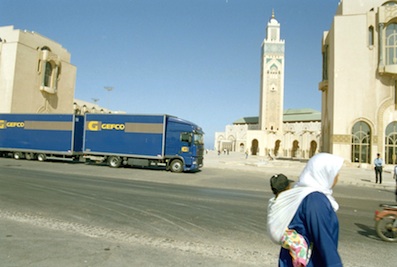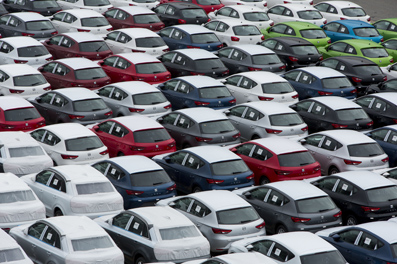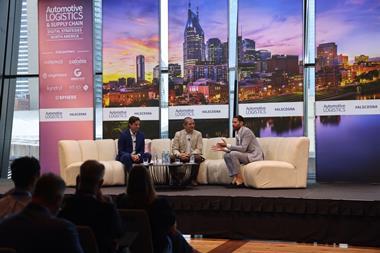Despite parts of the region striving for greater stability, North Africa presents significant opportunities for development throughout the automotive sector
 For some carmakers, especially in Europe, North Africa represents the next great frontier. In 2012, Algeria sold 450,000 new vehicles; Egypt 288,000 units; Morocco 126,000; and Tunisia 54,000. Outside of Egypt, growth this year has been strong, including a 10% sales increase in Algeria.
For some carmakers, especially in Europe, North Africa represents the next great frontier. In 2012, Algeria sold 450,000 new vehicles; Egypt 288,000 units; Morocco 126,000; and Tunisia 54,000. Outside of Egypt, growth this year has been strong, including a 10% sales increase in Algeria.
Manufacturers and suppliers cannot ignore the obvious political and social risk factors within North Africa and its restless neighbours, such as Syria. However, even though the situation has affected logistics efficiency in parts of the region, investment has been growing.
North Africa generally includes Morocco, Algeria, Tunisia, Libya and Egypt, with a combined population exceeding 172m. Overall, the strongest growth has been in Morocco for production parts and finished vehicles – especially for Renault Nissan production in Tangier – and in Algeria for vehicle imports. Among the biggest-selling carmakers in the region are Renault, Volkswagen and Peugeot-Citröen. Algeria imports many vehicles from Europe but also from China – more than probably serves the domestic market, say experts, suggesting that local importers also export these vehicles elsewhere in Africa. Spare parts demand is on the rise throughout the region as well.
Despite its growth trends, the region faces infrastructure and political challenges. Congestion is an issue at most of the ports, particularly in Algeria, and political instability has tempered expectations in some countries. Although the market has a high volume demand, financial agreements have become more of an impediment because of on-going conflicts. Regulations in North Africa also make land transport between countries impractical, limiting options for effective routing and multimodal transport. The border between Morocco and Algeria, for example, is closed.
The region represents considerable opportunities for logistics providers as well as manufacturers, and although competitive and political sensitivities can make it difficult for executives to speak openly, some are more willing than others to admit how the political situation in parts of North Africa has affected their logistics efficiency.

North Africa has a relatively limited automotive production network, including a few complete knockdown kit (CKD) plants in Egypt and Morocco, and a major assembly plant for Renault in Tangier, Morocco. However, along with serving Renault, a number of tier ones have based factories in the region to serve Europe and other global locations, including for parts such as wire harnesses. The result is that third party logistics providers provide a range of relatively low volume, piecemeal services, but many see opportunities for growth.
Gefco, for example, serves tier one inbound and outbound channels in Morocco and Tunisia. For vehicles, it handles both imports and exports in Morocco and Algeria. Jean-Paul Ornano, director of Morocco and head of Maghreb for Gefco, says the company moves 40% of vehicles in North Africa by truck, with the rest moving by sea. For parts, 84% move by road, 12% by ocean and the rest by air. In total, last year Gefco Maghreb transported 12,300 trailers, which included 65% to Tunisia, 31% to Morocco and 4% to Algeria.
Another 3PL, Geodis Supply Chain Solutions, runs a number of services in Morocco, Tunisia, and Algeria. Olivier Marchegay, automotive market director in North Africa, says that for Renault Morocco, Geodis ships parts from Moroccan suppliers to its plants. It also ships parts from tier one suppliers in Europe to Morocco and back to Europe. In Tunisia, it provides collections and deliveries for tier one suppliers, container and ro-ro flows to Europe, as well as air freight and customs clearance.
Groupe CAT also handles production parts for Renault and suppliers Lear, Valeo, Leoni, and Antolin, as well as spare parts. Gaxan Castanos, business unit manager for Spain, Portugal, Morocco and Tunisia, says it ships 60% of its Moroccan flow by intermodal road-ferry transport from Europe to Tangier for Renault’s local plant, and 40% to tier one suppliers in Morocco. A ferry sails from Spain to Morocco every two hours and Groupe CAT uses Tangier Med Port and nearby Tangier Automotive City Free Zone. “We ship about 100 loads per week. Volumes are increasing fast and will double next year with increased production at the Renault plant,” says Castanos. Moroccan freight accounts for 90% of Groupe Cat’s volume and Tunisian freight accounts for the remainder.
Groupe CAT invested in new equipment for its Europe-to-Maghreb business. “We are using mega-trailers for our automotive freight. Now, 100 trailers are in use, and 100 more are coming,” he says. “They are like containers for ro-ro vessels.” The trailer loads on the vessel at the port of Algeciras, Spain and unloads directly at the destination port.
DHL ships CKD parts by air for assembly in Egypt and Morocco. In Tunisia and Morocco, it also serves tier one suppliers for wire-harness production. Production parts account for 30-40% and spare parts for 60-70%, according to Fathi Tlatli, president of global automotive sector at DHL Customer Solutions and Innovation. Tlatli says that this year, DHL introduced dedicated cargo flights on 757 aircrafts to a hub outside of Casablanca.
As vehicle use rises, service parts are also in high demand in North Africa. DHL ships spare parts across the region, and especially to Morocco and Egypt. Volvo Group Logistics Services (VGLS) also serves Algeria and Morocco directly as well as Tunisia and Egypt through import partners. The company has hubs in Algiers and Casablanca, according to Anna Norinder, director of Russia, Middle East and Africa. “Our objectives are to reduce our lead times, improve our service levels and implement an improved IT system for our dealerships,” she says. “We also aim to balance our local presence versus the use of import partners.”
In Morocco, VGLS uses the ports of Tangier for spare parts, which it distributes to 13 locations in Algeria and ten in Morocco. In Algeria, VGLS serves Renault Trucks locally, as well as other Volvo Group companies. “Customs clearance in Algeria is highly regulated and takes time. Therefore, we try to maintain high parts availability in order to use road transport instead of air transport. We also maintain high parts availability in Morocco, even though customs there is straightforward,” says Norinder.
For 3PL provider UTi Worldwide, 90% of its North Africa business is in Egypt, where it operates directly. Jochen Freese, UTi’s regional president for Europe, Middle East and North Africa, says almost all of its business is production parts, typically wire harnesses, that ship from Egypt to Europe. The dominant transport methods are either ocean freight directly from the supplier or air freight.
UTi ships by ocean container and with trailers aboard ro-ro vessels. “Our dominant channel is ocean shipments to Port Said, Egypt, but due to less ro-ro capacity and port congestion, this is more difficult,” says Freese. The political strife in Egypt has led UTi to fly more parts. “Percentage-wise, it was in the single digits, but it has been more than 20% for the last 15 months,” he reveals.
VGLS serves Egypt with its hub in Dubai. “The border situation is not easy,” says Norinder. “We deliver as usual to Egypt, although volumes have declined due to the turbulence. The short-term outlook is not good, but we are still hopeful.”
"The political strife in Egypt has led UTi to fly more parts. Percentage-wise, it was in the single digits, but it has been more than 20% for the last 15 months," - Jochen Freese, UTi
Freese admits that unrest over the summer led to various stoppages. “Although the business climate in Egypt is more confident than it was after the first revolution there, large demonstrations have made it too risky to deliver to the customer’s plant, so there was a complete shutdown,” he says.
Balancing industry and infrastructure
Like other emerging markets, manufacturers and LSPs point to underdeveloped facilities and poor warehousing. “The problem is a lack of efficiency in infrastructure and cargo-handling facilities. The industry is growing faster than the infrastructure,” says Groupe Cat’s Castanos.
DHL’s Tlatli observes that sometimes it is easier to ship from Europe to North Africa than within North Africa. “The reason is the political situation and the fact that inter-country road movement fluctuates due to the vagaries of customs. When these things happen, business slows down, but then it comes back at a higher level, he says.
For Geodis and others shipping through the Strait of Gibraltar, the weather is another challenge. “Due to storms and other climatic constraints, we face a higher risk of exceeding our agreed door-to-door transit time,” says Marchegay. “We also face the risk of damage to our trucks and our trailers that ship between the ports of Algeciras and Tangier.”
With French and other European manufacturers growing in the region, providers like Gefco have expanded services, including for vehicle logistics. Last year it transported 120,000 finished vehicles, which consisted of 75% to Algeria, 17% to Morocco, and 8% to Tunisia. Approximately 80% of its finished vehicles bound for North Africa originate in Europe. In Morocco, Gefco’s main customers are Renault, Peugeot-Citroën, Volkswagen, Skoda, Audi, and Nissan. In Algeria and Tunisia, the company’s main customer is PSA.
Algeria is Volkswagen Group member Seat’s largest destination outside of Europe, and its fastest growing destination in the region, according to Manuel Medina, manager of finished vehicle distribution. Primarily, Seat ships to the port of Mostaganem in northwest Algeria, which is located near Oran, its second largest city and close to where Renault plans to open a plant by 2015. Seat also uses the northeastern port of Djen Djen, but to a lesser extent.
Grimaldi Lines is one of the major ro-ro carriers serving North Africa, going to Egypt, the ports of Casablanca and Tangier, Tunis, and the port of Khoms in northwestern Libya. Costantino Baldissara, commercial and logistics director of the Grimaldi Group, says the North African market focuses primarily on used cars and on loaded trailers, while new cars, heavy machines and containers are secondary, but significant. The shipping line has not seen much disruption from the recent unrest. “Political instability in North Africa has not affected Grimaldi Lines’ service quality. Volumes remained stable and ports remain operational,” states Baldissara.
Piraeus, Greece-based Neptune Lines, ships new and used cars and equipment as well as energy machinery. It serves the ports of Tangier and Casablanca for imports and exports, and Djen Djen, Mostaganem, Tunis, and Egypt’s Alexandria for imports. Peter Menzel, managing director, says that Neptune Lines calls Egypt, Libya, and Algeria for spot shipments.
Storage terminals
For finished vehicles, Gefco operates storage centres in Casablanca and Tangier with a total capacity of 13,000 units as well as a 15,000-unit facility in Algeria. Ornano says Gefco plans to open a 4,000-unit site in Tunis. STVA, which is part of the Geodis Group, serves Renault and other carmakers in the region. STVA manages the Common User Vehicle Terminal (TVCU) at the port of Tangier alongside Renault’s terminal. The 5.7-hectare facility, which opened in January, has a capacity of 3,000 vehicles. STVA also provides vessel loading and unloading at the terminal.
Dominique Negre, STVA’s marketing and prospective director, says it uses TVCU for vehicle transhipments, such as one that moves by short sea from Turkey to Tangier and then by deep sea to South Africa. Other examples are Nissan’s shipments from Spain to Tangier, which then move by deep sea to Australia and New Zealand.
Ocean challenges
Port congestion and inland connections can have a real impact on North Africa’s vehicle supply chain. According to Medina, Seat’s use of importer compounds in Algeria is critical because the ports do not have sufficient infrastructure to manage large quantities of vehicles. The Spanish carmaker’s other destination ports are Casablanca, Tunis and Alexandria.
In Algeria, the highest storage capacity is at the port of Djen Djen, which can hold 20,000 units. The problem is a lack of inland vehicle distribution centres, says Neptune Line’s Menzel. Port infrastructure has not kept pace with growth, which causes bottlenecks at the terminals. Menzel notes that the Moroccan ports of Casablanca and Tangier, along with Tunisia’s Tunis, are less congested than are Algerian ports.
"Seat uses ferry lines that link Barcelona and Tunisia, which would benefit greatly from improvement" - Manuel Medina, Seat
Tunisia has also had political problems, which has impacted shipping and logistics flows. “The best approach for us is flexibility in scheduling the right tonnage and vessel sizes to meet the changes in demand,” says Menzel.
Vehicle flows are far from balanced in the region, with high volumes into certain parts of Algeria, and fewer vehicles into others. Medina points out that it is difficult to share capacity with other manufacturers to low-volume Tunisia, which has no shipping route dedicated solely to vehicles. “In this case, Seat uses ferry lines that link Barcelona and Tunisia, which would benefit greatly from improvement,” says Medina.
Despite these limits, and the political unrest, the automotive sector in North Africa is developing quickly. Gefco’s vehicle imports to Morocco grew by 14% in 2011 and by 160% each to Morocco and Algeria in 2012. In the first half of 2013, Seat sold 11,335 vehicles to Algeria, which is an increase of 118.4% over the same period last year, according to Medina.
Along with this growth, the logistics network is continuing to develop. Given the risk and volatility, a flexible logistics infrastructure is an absolute necessity.





































